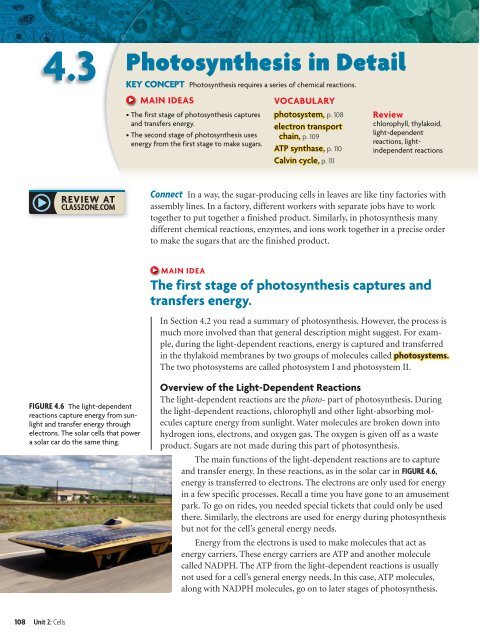Cells and Energy
Cells and Energy
Cells and Energy
Create successful ePaper yourself
Turn your PDF publications into a flip-book with our unique Google optimized e-Paper software.
4.3Photosynthesis in DetailKEY CONCEPT Photosynthesis requires a series of chemical reactions.MAIN IDEAS• The first stage of photosynthesis captures<strong>and</strong> transfers energy.• The second stage of photosynthesis usesenergy from the first stage to make sugars.VOCABULARYphotosystem, p. 108electron transportchain, p. 109ATP synthase, p. 110Calvin cycle, p. 111Reviewchlorophyll, thylakoid,light-dependentreactions, lightindependentreactionsConnect In a way, the sugar-producing cells in leaves are like tiny factories withassembly lines. In a factory, different workers with separate jobs have to worktogether to put together a finished product. Similarly, in photosynthesis manydifferent chemical reactions, enzymes, <strong>and</strong> ions work together in a precise orderto make the sugars that are the finished product.MAIN IDEAThe first stage of photosynthesis captures <strong>and</strong>transfers energy.In Section 4.2 you read a summary of photosynthesis. However, the process ismuch more involved than that general description might suggest. For example,during the light-dependent reactions, energy is captured <strong>and</strong> transferredin the thylakoid membranes by two groups of molecules called photosystems.The two photosystems are called photosystem I <strong>and</strong> photosystem II.FIGURE 4.6 The light-dependentreactions capture energy from sunlight<strong>and</strong> transfer energy throughelectrons. The solar cells that powera solar car do the same thing.Overview of the Light-Dependent ReactionsThe light-dependent reactions are the photo- part of photosynthesis. Duringthe light-dependent reactions, chlorophyll <strong>and</strong> other light-absorbing moleculescapture energy from sunlight. Water molecules are broken down intohydrogen ions, electrons, <strong>and</strong> oxygen gas. The oxygen is given off as a wasteproduct. Sugars are not made during this part of photosynthesis.The main functions of the light-dependent reactions are to capture<strong>and</strong> transfer energy. In these reactions, as in the solar car in FIGURE 4.6,energy is transferred to electrons. The electrons are only used for energyin a few specific processes. Recall a time you have gone to an amusementpark. To go on rides, you needed special tickets that could only be usedthere. Similarly, the electrons are used for energy during photosynthesisbut not for the cell’s general energy needs.<strong>Energy</strong> from the electrons is used to make molecules that act asenergy carriers. These energy carriers are ATP <strong>and</strong> another moleculecalled NADPH. The ATP from the light-dependent reactions is usuallynot used for a cell’s general energy needs. In this case, ATP molecules,along with NADPH molecules, go on to later stages of photosynthesis.108 Unit 2: <strong>Cells</strong>
















